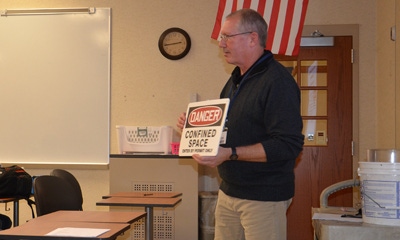
Many of you don’t have more than 10 employees on your farm. Some of you don’t have any, except yourself and perhaps your spouse or maybe a son or daughter. Mike Manning says those of you who have more than 10 employees already know what the Occupational Safety and Health Administration requires when it comes to safety in the workplace.

NO SIGN REQUIRED? You only need to post signs warning that you are entering a confined space if you fall under OSHA guidelines, Mike Manning says. However, do your employees know the risks of confined spaces?
Manning often makes the point by holding up a "Confined spaces" safety sign. “If you have 10 or fewer employees, your farm is exempt and you don’t have to post this sign,” he says. Manning is a former Purdue University Extension ag educator and supervisor who now presents safety programs, primarily on safety in confined spaces, and primarily to potential young workers. He works for Bill Field, Purdue’s farm safety specialist.
There are a number of rules and regulations a business which falls under OSHA’s authority has to meet which a farm that is exempt doesn’t have to do, Manning says. Here are just five. And although you are not required to follow them, and they may seem like overkill in some cases, some might be worth considering or adopting in some form — even if you aren’t required to do so by law.
1. Post a sign at the grain center warning employees that they are about to enter a confined space.
Whether you are required to post the sign or not, it’s a good idea to make sure workers and family members understand the dangers associated with working around grain, Manning says.
2. Require workers or family members entering the confined space to sign in and sign out.
Is this overkill if you have just a couple of employees? Maybe — you can decide. It’s required for those business not exempt from OSHA. Here’s one advantage — if you have the system and employees follow it, you’re going to know if someone is in a grain bin or not when you can’t locate them.
3. Develop an emergency contingency plan, and make sure everyone understands it.
You certainly don’t need 11 or more employees to have an emergency on your farm. What if one occurs? Does each family member or employee know how to react? Do they know who to call? Do they know to stay on the line with a 911 operator until help has arrived? This would be perfect discussion material for a family safety meeting, Manning says.
4. Provide personal protection items for employees.
This one is just common sense. If an employee is going into a grain bin to finish cleaning it out and preparing for the next crop, he needs to wear a mask. And he needs to wear a mask appropriate for the hazards he might encounter, Manning notes.
5. Provide proper tools to determine if a confined space is safe.
If you’re going into a confined space, there are devices that can measure the percentage of oxygen in the air in the space. If your farm is exempt, you are not required to carry one. They can be valuable because they can alert you if the concentration is low, Manning says. “You want at least 19% oxygen as a minimum before you enter a space,” he says.
To see a sample of an air oxygen measuring device, visit greisinger.de.
About the Author(s)
You May Also Like




